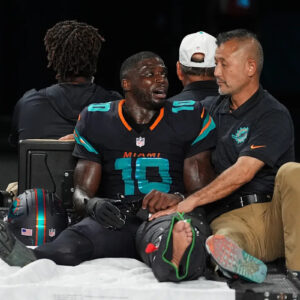A span of time measuring four hours, four minutes, and thirty-seven seconds. The 2011 Canadian Grand Prix is celebrated for a couple of prominent reasons: first, its status as the longest race ever held in Formula 1 (a distinction unlikely to be surpassed), and second, Jenson Button’s unexpected triumph after navigating his way from the very rear of the pack.
It stands as one of Button’s most exceptional performances, a race where he contended with the demanding conditions (and a fair amount of on-track incidents) to progress from the back of the field all the way to the front position.
Undoubtedly, critics might contend that Button bore some accountability for the collisions involving Lewis Hamilton and Fernando Alonso, and that McLaren significantly aided his effort with a downforce-optimized configuration. Nevertheless, he persevered – and ultimately secured the win more than four hours after the race commencement.
By every description, Button experienced intense competition throughout the initial portion of the race. The starting phase unfolded with the safety car leading the cars for the first four circuits, and he only traveled three additional laps before encountering his first contact involving McLaren colleague Hamilton. Hamilton achieved a superior qualifying position compared to Button – starting in fifth, in contrast to Button’s seventh – but ceded ground after colliding with Mark Webber at the second turn while attempting an evasive maneuver.
Subsequently, a series of overtakings occurred, influenced by brief excursions beyond the track boundaries: Button steered wide at the sixth turn, permitting Michael Schumacher to slip into fifth place, and Hamilton re-passed as Button labored to manage his drifting vehicle. During the subsequent lap, the sixth overall, Hamilton sought to overtake Schumacher at the hairpin turn – yet the seven-time titleholder maintained the future seven-time victor off the most efficient racing line, enabling Button to regain sixth.
At the conclusion of the seventh circuit, the McLaren vehicles collided. Hamilton attempted to position his machine on Button’s left along the main straight, while Button was shutting the avenue. This situation was remarkably replicated around 14 years later when Oscar Piastri and Lando Norris restaged a parallel occurrence – again, the pilot endeavoring the pass suffered the more adverse outcome.
Button acknowledged his lack of awareness of Hamilton’s approach. Hamilton sustained damage to his left-rear tyre, prompting him to withdraw and activate the deployment of the safety car. Button utilized the safety car phase to execute a pit stop, exchanging his full-wet tyres for the intermediate compound to reappear in 12th position. However, he subsequently received a penalty for exceeding the speed restriction during the safety car segment. Consequently, he served a drive-through penalty once the safety car withdrew, dropping him to 15th.

Hamilton tried to pass Button at the end of the seventh lap – but it was in vain
Photo by: Andy Hone / Motorsport Images
With the opportunity now present to fully exploit his intermediate tyres, Button rapidly advanced through the field of competitors using wet-weather tyres, maintaining notably quicker pace compared to the front-running Sebastian Vettel. Upon reaching Paul di Resta of Force India, together with the two Renault vehicles, advancement slowed somewhat, although di Resta was eventually overcome, promoting Button to eighth.
Almost immediately after Button overtook Vitaly Petrov for seventh position, the rainfall intensity increased. The previously dry path across the track vanished swiftly, as did the advantages conferred by the intermediate tyres. Visibility also diminished significantly, and a dense mist veiled the far straightaway, leading to the activation of the safety car in anticipation of further deterioration in circumstances.
Subsequently, Button reverted to the wet tyres. Continuous rain enveloped the Ile Notre-Dame circuit, and following 24 circuits, the race was formally suspended. It remained in this state for an additional two hours.
Following the lengthy pause and numerous circuits guided by the safety car, Button overtook Pedro de la Rosa (substituting for the injured Sergio Perez) upon the restart, executed a pit stop for intermediate tyres, and then pursued Fernando Alonso after the Ferrari pilot encountered issues during his team’s double pit-stop procedure for intermediate tyres. This culminated in a collision between the two competitors at the third turn, resulting in Alonso becoming stranded on the kerb and prompting the deployment of the safety car after only a pair of laps under standard race conditions. This incident relegated Button to 21st place – the absolute tail position – as he cautiously guided his vehicle towards the pit area with a punctured tyre and impaired front wing.
“But it was delightful,” Button documented in his autobiography, entitled Life to the Limit. “I centered my focus and commenced my advance, steering with an unprecedented smoothness and velocity, and initiating a return to the front […] manipulating my McLaren akin to operating a go-kart during my juvenile years.”
Thereupon, the recovery commenced during the lap 41 restart. The HRT vehicles offered scant impedance during the restart, a characteristic mirrored by the Virgin cars and the solitary remaining Lotus, piloted by Jarno Trulli. Within a span of 10 circuits, Button had ascended back into the uppermost 10, although he opted to relinquish his station anew by gambling on slick tyres following the conclusion of lap 51. At that juncture, a noticeable dry route had begun to form upon the soaked track exterior, rendering the supersoft Pirelli tyres distinctly superior. Anticipating an undercut, Button conceded eighth position, exchanging it for seventh.
The tumultuous conditions persisted. Felipe Massa experienced aquaplaning while attempting to overtake an HRT, precipitating the detachment of his front wing. Kamui Kobayashi and Petrov executed their pit stops one lap tardily and proved to be straightforward targets for Button, who additionally overtook Nick Heidfeld to secure fourth position. A gap of seven seconds separated Button from the contest for second place between Michael Schumacher and Mark Webber, who themselves trailed long-standing leader Sebastian Vettel by 10 seconds.
When Heidfeld collided with Kobayashi, as the Sauber vehicle demonstrated a markedly sluggish acceleration from the second turn in juxtaposition to the Renault, fragments of the detached front wing scattered across the racecourse. This led to the reappearance of the safety car, albeit for a brief duration of four laps, bringing the foremost four drivers into contention.

Button made six trips to the pitlane – one for a drive-through after speeding behind the safety car
Photo by: Rainer W. Schlegelmilch / Motorsport Images
Preceding him, Button faced the obstacle of the lapped Timo Glock, occurring during an era before the implementation of regulations permitting all lapped competitors to unlap themselves via authorization from the race director, seemingly freeing the uppermost trio in advance of the concluding 10-lap showdown.
Upon successfully passing Glock, Button swiftly closed the distance to Webber, who was in the midst of attempting an inside maneuver against Schumacher. Webber’s act of circumventing the chicane at the end of the 64th lap and subsequently decelerating created an opportunity for Button to capitalize and acquire another placement. Then, utilizing the Drag Reduction System on the succeeding lap, Button forcefully took second position from Schumacher. The race had only five laps remaining, and Button faced the challenge of reducing a 3.1-second gap to Vettel.
Vettel exercised prudence in his driving approach. Demonstrating proficiency in damp conditions, he had developed a secure advantage across the initial 60 circuits. However, the late activation of the safety car negated his buffer, and the persistent hazards presented by the track’s surface were poorly matched to his vehicle’s low-downforce configuration. As a result, Button lessened the deficit by half within a single lap and sustained pressure, thereby compelling Vettel to escalate his speed for the first occasion that afternoon.
The defining instant transpired during the final lap. Button positioned himself within the range for utilizing the Drag Reduction System and advanced closer to Vettel’s tail, but it was the reigning champion who inadvertently contributed to Button’s triumph. A skid at the sixth turn propelled the Red Bull vehicle away from the optimal route, bequeathing the lead and an enormous victory to Button. He had progressed from the rear to the front within only 30 circuits, having coerced the reigning champion into committing a crucial error during the climactic stage.

Button secured the first of three wins in 2011, helping his charge to second in the championship
Photo by: Sutton Images
How the 2011 Canada Race Forever Changed Wet-Weather Racing Conventions
Following the hiatus marked by the two-hour red flag, the Montreal competition revealed a regulatory inadequacy: the absence of a stipulated maximum race duration extending beyond the two-hour limit for active racing. Consequently, a four-hour constraint was enacted to ensure competitions remained unthreatened by impending nightfall. This constraint was subsequently shortened to three hours in 2021.
Traditionally, the deployment of red flags by Formula 1’s race administrators had typically been limited to responses to incidents; however, the action taken in Canada stemmed directly from prevailing weather conditions. At that juncture, drivers had articulated a desire for a more proactive stance from race officials concerning the suspension of races under particularly severe conditions, aiming to circumvent continuous racing that could potentially result in injuries.
The acceptance of red flags in advance of severe weather conditions has gained substantially greater traction in recent times. Despite the lighthearted criticism from Formula 1 fans regarding the limited effectiveness of Pirelli’s wet-weather tyre compound, whose usage is commonly accompanied by an interruption in racing, the paramount concern in contemporary wet races revolves around impaired visibility, rather than the degree of grip provided by the track.
In the recent past, Formula 1 and the Federation Internationale de l’Automobile have endeavored to resolve this matter and have assessed the effectiveness of wheel guards in alleviating spray, an issue intensified by present aerodynamic designs. Whether the protocols to be implemented in 2026 will naturally address a segment of this issue remains uncertain, particularly given the reductions in tyre width and bodywork anticipated for the approaching year, but there should be a minor enhancement regardless.
While a tendency exists to criticize the cautious approach adopted in today’s wet races, the strengthened capability of the race director to proactively manage circumstances characterized by adverse weather is arguably preferable to passively awaiting an unfortunate occurrence.














